I have three books to recommend for your summer reading: a brand new collection of short stories; a twentieth century classic; and Jared Diamond's stunning 1996 study of why the West won– that would be the West as in the culture that developed in the great Euro-Asian landmass. The book is GUNS, GERMS, AND STEEL, which answers the question posed to Diamond by a New Guinean friend who didn't understand why Europeans had come out on top in his world rather than vice versa. And Diamond , who deeply believes 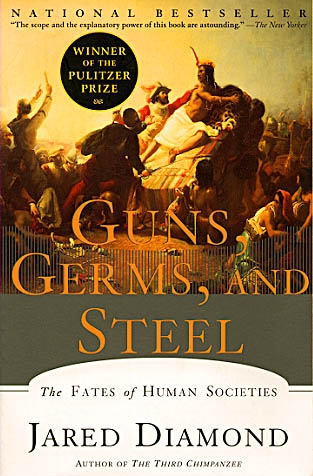 that people like his New Guinean friend are at least and maybe more intelligent than the average European, made this magisterial survey. There is no single answer, of course, but rather a coming together of many elements in the cultures with the technological advances that gave them the ability to engulf other people's lands, resources, languages, and gene pools.
that people like his New Guinean friend are at least and maybe more intelligent than the average European, made this magisterial survey. There is no single answer, of course, but rather a coming together of many elements in the cultures with the technological advances that gave them the ability to engulf other people's lands, resources, languages, and gene pools.
One essential element turns out to be the availability of plants and animals that can be domesticated for food and other uses. Diamond distinguishes between animals that can be tamed, like my parakeet, and animals that can be domesticated and used for food, transportation, etc. Animals turn out to be not only essential tools of war and agriculture, but also vectors for the great epidemics that spread over the Asia-Europe land mass, killing off millions, but also leading to some immunity in the survivors-- and eventually to unconscious (at least at first) germ warfare against more isolated people like those of the Americas.
Diamond also discusses what he calls the axis of communication. The axis of Eurasia is east west, which meant that many crops and animals would be in same general latitude for eventual expansion. He compares this to the Americas with a north-sound axis and barriers of climate, latitude, and topography that meant the Aztecs and the Incas barely knew of each other, and that maize was probably domesticated more than once. Africa had the great barrier of the Sahara between north and south plus certain terrible diseases of the subsaharan rain forests that stopped horses and cattle from moving south
Diamond's knowledge and his relentless enthusiasm for sharing it are a real delight. It's a book with big, expansive ideas that make you feel, at least for a moment, that you're got some perspective on history and geography.
Next, I want to recommend LITTLE AMERICA by Diane Simmons. This is a 2011 short story collection of shapely, separate stories that are made stronger by being grouped together. First, truth in advertising: I blurbed this book, but in rereading it as a whole, I find it even better than my first look. It is a book of stories about Americans on the move, mostly on the road. These are people who run away or drift away, going on the road, leaving their lovers and families. It begins with a family of grifters and ends with some shrewdly dishonest drifters– who may or may not be going into more danger than they're escaping. The longest story, "Letters," is about the ideal of romantic love as a destructive force, especially for women in the 1950's.
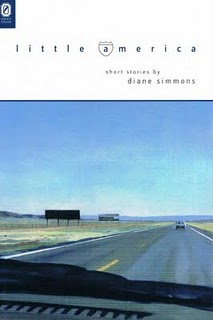 There is plenty of humor and horror, lots of feisty characters and lost characters and American landscape. So the parts are excellent, but the collection really succeeds in its grand design. I am a deep admirer of shape– I feel that shaping our world is one of the major reasons we read and write fiction. Simmons creates the shape of her book with repetition and unexpected turns, especially with her excellent endings.
There is plenty of humor and horror, lots of feisty characters and lost characters and American landscape. So the parts are excellent, but the collection really succeeds in its grand design. I am a deep admirer of shape– I feel that shaping our world is one of the major reasons we read and write fiction. Simmons creates the shape of her book with repetition and unexpected turns, especially with her excellent endings.
One story, "Suitcase," set mostly in Guatemala, has been called a modern "Heart of Darkness," which is nicely apt, except that Simmons' story is both more compact and more shocking– and more realistic– than Conrad's classic. You feel something bad coming, but you don't see the actual end. A story at the other extreme of weather has two young people going homesteading in the Yukon, and this one too has a satisfying surprise at the end. Simmons is wonderful at what you might call earned surprises. Endings tend to be a problem for contemporary writers, and maybe especially writers of short stories, but Simmons breaks new ground. The stories in LITTLE AMERICA don't end with gunshots or rape, but with genuine enlightenments: sometimes nasty, sometimes amusing, but almost always the thing you didn't expect, but which feels absolutely right. I'm not going to reveal any endings here, except to say that each story has a payoff, and the collection as a whole pulls you in and doesn't let you go.
Finally, I reread Franz Kafka's THE TRIAL (free for Kindle!). This is one of those books that blew me away thirty-five years ago, and I sometimes think of it or maybe the feeling it gave me (would that be "kafkaesque"?). But re-reading brought an entirely different experience from what I remembered. It is an unfinished book, with scholarly and biographical debate about what belongs in, the order of chapters, and, of course, if Kafka really meant it when he asked to have his work destroyed after his death.
One of the things I didn't remember is that it is a novel that is crowded with characters and funny and absurd passages, and also sex, as well as being famously off-kilter and disturbing. How odd, though, that my memory of the book was of loneliness, especially the execution at the end. In fact, though. the places of Josef K.'s life are crowded with people: his office, the 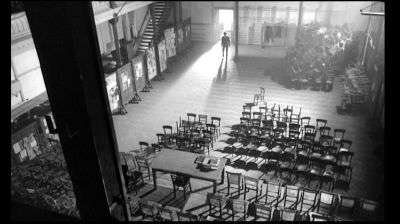 rooming house where he lives, the various squalid apartment blocks where he findscourtrooms and officials' offices in a warren of working class flats. The novel starts with police (or something like police) pushing into K.'s bedroom as he's getting up, and ends with two fat executioners and someone watching perhaps sympathetically from a window. And my memory of the end was of a final scene (possibly from the movie?) in which a door opens and light falls on man on pallet, and he says Is it time? But the novel is weirder, and sillier, and more moving.
rooming house where he lives, the various squalid apartment blocks where he findscourtrooms and officials' offices in a warren of working class flats. The novel starts with police (or something like police) pushing into K.'s bedroom as he's getting up, and ends with two fat executioners and someone watching perhaps sympathetically from a window. And my memory of the end was of a final scene (possibly from the movie?) in which a door opens and light falls on man on pallet, and he says Is it time? But the novel is weirder, and sillier, and more moving.
I ran across an article by John Banville about his rereading of the novel, (from the UK's Guardian as http://www.guardian.co.uk/books/2011/jan/15/john-banville-kafka-trial-rereading) . Banville suggests that the book used for its structure an event in Kafka's on-again off-again engagement when his fiancee brought him to a meeting with a friend and herself where she put him through a kind of trial over their relationship. Marriage, Banville thinks, was to Kafka a kind of capital sentence. If this sounds overly psychological or even diminishing to his accomplishment in the novel, I would say that great artists demonstrate their greatness not by the loftiness of their subjects but by how they take whatevermaterials are at hand and make a great thing out of them. Art moves even quotidian things to another level, makes a leap that allows us all to participate in something that may have begun as local or individual.
This brings me to a question: when you re-read the works that you met as a young person, do you find them very different: In what way? Do they hold up? Are they entirely different?
READERS RESPOND
Ardian Gill said of THE GOOD SOLDIER (discussed in Issue # 142), "I was surprised at your take on Ford (Heuffer)'s THE GOOD SOLDIER with its famous 'Saddest Story' (original title) opening line. I'm an old fan of Ford's, not least because his main character in the quartet (PARADE'S END), Tietjens, is an actuary. I'm going to forward Jane Smiley's review in the Guardian. BTW, Ford alleges that he taught Conrad English." [The excellent review/appreciation by Jane Smiley is at:
http://www.guardian.co.uk/books/2006/may/27/featuresreviews.guardianreview27 ]
Debbie Carter writes, "THE GOOD SOLDIER is one of my favorite novels. I want to read it again soon for the way he captures longing for a beloved and how they will do anything, anything to be with that person, even if they suspect they're being lied to and don't want to know."
Debbie also recommends, just for fun, "an online questionnaire.... called "Which Vintage Classics Character Are You?" It's posted on Facebook by Random House Australia." Here's the link (you have to "like" them to get to take it)
http://www.facebook.com/randomhouseaustralia?sk=app_4949752878
Laura Bentley sends a link to this 1958 television interview of Pearl S. Buck by Mike Wallace: http://www.hrc.utexas.edu/multimedia/video/2008/wallace/buck_pearl.html . It really takes you back to another time and place– Wallace is determined to pigeonhole Buck, and she is very ladylike, but very determined to be who she is!
Jonathan Greene recommends the movie version of NORTH AND SOUND, available on Netflix.
RECOMMENDATION OF A WRITER'S CONFERENCE
Suzanne Rahn writes about a writer's conference she attended in San Francisco. She says, " I enjoyed this conference very much. I stayed at the Fort Mason Hostel which was a 5 minute walk to the conference and 20 min walk to Fisherman's Wharf. I would recommend the hostel as an extremely affordable place to stay. There is even a small café in the building where you can overlook Alcatraz Island sipping a cup of chai tea. Very nice area.
http://fwwriters.algonkianconferences.com/
She goes on to say, "Michael Neff's credentials are listed on the website and his style is that of a literary "Simon Cowell" but not so heartless. His workshop is designed to help a writer improve, but he also won't sugar coat his opinion. His goal is to further a good story or help rescue a terrible story. I met several agents and publishers during the week and established a cordial friendship with Michael and the owners of the Larsen/Paloma agency. I would highly recommend this conference to any writer who wants to take a serious step towards firming up and pitching his or her novel."
VALERIE NIEMAN ON TOUR WITH HER NOVEL BLOOD CLAY (see issue #140)
JULY 10 - Meet the Author at Rosemary House, Pittsboro, NC
JULY 16 - Literary Bookpost, Salisbury, NC
JULY 30 - North Carolina Writers Conference in Asheville, NC
JULY 31 - Reading at Malaprop's, Asheville
AUG. 27 - Fiction workshop in Yadkinville, NC
SEPT. 10 - BookMarks in Winston-Salem, NC
SEPT. 30-OCT. 3 - Virginia tour TBA
OCT. 6 - Ex Libris Book Club
OCT. 13 - Fairmont State University, Fairmont, WV
OCT. 14 - West Virginia University
OCT. 15 - Weirton, WV, Public Library
OCT. 17 - Alderson-Broaddus College, Philippi, WV
FAN FICTION– A NEW GENRE??
A whole new world of writing is taking place online with Fan Fiction, in which fans write 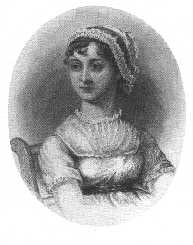 stories associated loosely or tightly with their favorite author, classic, or genre. Mindy Kesterman, along with her freshly-minted Princeton graduate daughter, provided this overview of Jane Austen fan fiction sites:
stories associated loosely or tightly with their favorite author, classic, or genre. Mindy Kesterman, along with her freshly-minted Princeton graduate daughter, provided this overview of Jane Austen fan fiction sites:
dwiggie.com
meryton.com/aha
austenunderground.com
Mindy writes: "You can post a chapter for commentary by other fans, or there are parts of the sites where you can ask for editing or a beta reader. A work in progress can be posted at say the rate of a chapter or two a week and fans return to read the serialized novel." There is also an is an index of all Austen fan fiction is available at jaffindex.com – but for this one, you have to have a membership in one of the Austen fan fiction sites.
READ ONLINE
An interview with writer and BELLEVUE LITERARY REVIEW Fiction Editor Suzanne McConnell is posted at http://www.thereviewreview.net/interviews . The interview focuses on the magazine and her own writing.
Leora Skolkin-Smith has an interesting piece on Grace Paley. She tries to correct Paley's position in the literary-spiritual-political arena– very thoughtful and worth considering, especially how Skolkin-Smith presents Milan Kundera and Grace Paley as the East and West voices of the Cold War era, striving in different but complementary ways to preserve the souls of people in the second half of the twentieth century. The piece is at
http://quarterlyconversation.com/the-legacy-of-grace-paley
Juanita Torrence-Thompson's half-hour radio show, with music, produced by Poets West called "QUEENS MEETS ASIA," can be heard online now. Click on the home page of www.poetswest.com and scroll down to Radio Programs. The programs are large mono.mp3 files and you need hi speed internet to listen. Juanita's program is #194.
SAVE YOUR UNCORRECTED PROOFS!
ANNOUNCEMENTS, CONTESTS, READINGS, ETC.
 Carter Seaton's second novel, amo, AMAS, AMAT…AN UNCONVENTIONAL LOVE STORY is now available for Kindle readers, with other e-reader formats and a trade paperback print version coming soon. The novel, set in 1983, centers on Mary Cate Randolph who falls for tennis pro Nick Hamilton. He's charming and intelligent, but not sexually aggressive. Mary Cate, a naïve homophobic, is shocked to learn after they marry that Nick is a closeted homosexual. What follows is not what you'd expect.
Carter Seaton's second novel, amo, AMAS, AMAT…AN UNCONVENTIONAL LOVE STORY is now available for Kindle readers, with other e-reader formats and a trade paperback print version coming soon. The novel, set in 1983, centers on Mary Cate Randolph who falls for tennis pro Nick Hamilton. He's charming and intelligent, but not sexually aggressive. Mary Cate, a naïve homophobic, is shocked to learn after they marry that Nick is a closeted homosexual. What follows is not what you'd expect.
Gerald Swick, who writes about the history of West Virginia, has an article in the new edition of Wonderful West Virginia magazine (http://www.wonderfulwv.com/) on the battle of Philippi. He says that he also "wrote a sidebar on the two cannons used at the battle. For decades they have been believed to be in Wellington, Kansas. Last autumn I went there, photographed them, and began a search to see if these were, indeed, the guns used at 'the first land battle of the Civil War.' The sidebar summarizes what I found."
THE WRITER'S ALMANAC featured one of of Jonathan Greene's poems on May 19, 2011. This is the third poem they have selected from his latest collection DISTILLATIONS AND SIPHONINGS.
Barbara Crooker has new poems up at the following sites:
http://www.stringpoet.com/2011/05/barbara-crooker/ ("Today" and "A Woman Is Her Mother")(There's music to go with this, too.) and http://www.decompmagazine.com/roominnewyork1932.htm ("Room in New York")(There's an audio clip of me reading the poem.)
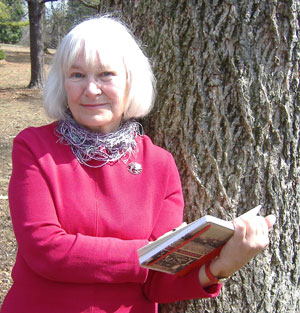
Mary Lucille Deberry's collection BERTHA BUTCHER'S COAT was one of the winners of Writers' Digest's competiion for self-published books of poetry. Other winners included first place Charles James for LIFE LINES , Drew Dellinger's LOVE LETTER TO THE MILKY WAY, and Jerry Brown Schwartz's SO INSPIRED: PRELUDES & POEMS,
ANDERBO SEEKS NOVELIST (by September 21st, 2011) for its 2nd Bi-annual No-Fee Novel Contest The Mercer Street Books Fiction Prize. Anderbo.com wishes to post up to the first 36 manuscript pages of an unpublished novel on its website by December 21st, 2011 for at least the following six months. We will look at the FIRST 36 PAGES (up to 9,000 words) of your e-manuscript submitted to editors@anderbo.com and decide within 60 days of its arrival if we want to see more. You must submit your manuscript entry within the body of the e-mail—no attachments. There is no reading fee, and and all literary rights will remain with the author. This contest is not open to anyone previously published on anderbo.com at any time. There will be an honorarium of $500 paid by the sponsor of this contest, Mercer Street Books & Records, to the winning author upon publication on Anderbo. For more, go to anderbo.com
NEW JERSEY SPECIAL! Michael C. Gabriele's THE GOLDEN AGE OF BICYCLE RACING IN NEW JERSEY has just been published. Check it out at The History Press https://www.historypress.net/ along with lots of other history books.
MSW NEWS:





 stories associated loosely or tightly with their favorite author, classic, or genre. Mindy Kesterman, along with her freshly-minted Princeton graduate daughter, provided this overview of Jane Austen fan fiction sites:
stories associated loosely or tightly with their favorite author, classic, or genre. Mindy Kesterman, along with her freshly-minted Princeton graduate daughter, provided this overview of Jane Austen fan fiction sites: Carter Seaton's second novel, amo, AMAS, AMAT…AN UNCONVENTIONAL LOVE STORY is now available for Kindle readers, with other e-reader formats and a trade paperback print version coming soon. The novel, set in 1983, centers on Mary Cate Randolph who falls for tennis pro Nick Hamilton. He's charming and intelligent, but not sexually aggressive. Mary Cate, a naïve homophobic, is shocked to learn after they marry that Nick is a closeted homosexual. What follows is not what you'd expect.
Carter Seaton's second novel, amo, AMAS, AMAT…AN UNCONVENTIONAL LOVE STORY is now available for Kindle readers, with other e-reader formats and a trade paperback print version coming soon. The novel, set in 1983, centers on Mary Cate Randolph who falls for tennis pro Nick Hamilton. He's charming and intelligent, but not sexually aggressive. Mary Cate, a naïve homophobic, is shocked to learn after they marry that Nick is a closeted homosexual. What follows is not what you'd expect.
